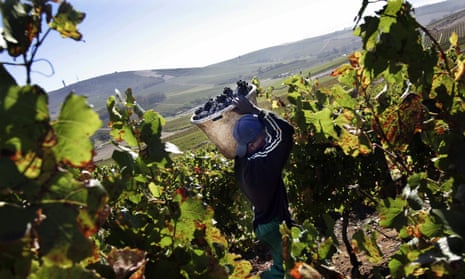Just as South Africa’s white wines have been undergoing a revolution (see last week’s column), so have its reds. At one time, you might have described them as classic “New World” (even though the country’s winemaking history goes back to the 17th century): big, ripe, full-bodied, wannabe Aussie blockbusters. Nowhere is the new approach more evident than with pinotage, a cross between pinot noir and cinsault that South Africa has made its own. Today’s versions are a far cry from the espresso-laden “coffee” pinotage that was all the rage just a few years ago; now, it’s much more like those original grape parents: fresh, juicy and, as one winemaker described the style to me, utterly “smashable”.
David and Nadia Sadie (no relation of the better-known Eben) make one of the most delicious up in the Swartland: the gorgeously gulpable Paardebosch Pinotage (£15.95, Vincisive; 12.5% abv) is a wine you could even serve lightly chilled with a piece of seared tuna. Fram’s vibrant Pinotage 2012 (£29, Swig; 14% abv) is also a cracker – as, indeed, it should be for that price. These small (in terms of production, not height) South African producers are redefining what fine wine is about.

Cinsault (aka cinsaut) is also getting time in the sun in its own right, and is one of the reds to watch in 2016. Many of the most exciting ones I tried still have to make it over here, but in the meantime enjoy Waterkloof’s Seriously Cool Cinsault 2014 (£11.99 D Byrne of Clitheroe, £13.25 Palmers Wine Store, £13.49 Harrogate Fine Wine Co; 14% abv) next time you have a plate of charcuterie.
Other Mediterranean grapes in the spotlight are grenache (Sadie’s again is stellar), carignan and syrah (the French spelling indicates the style this new generation of winemakers are aiming for). Often they pop up in blends such as the incredibe Blank Bottle Familie Moord 2014 (£25 Swig; 14% abv), which has grenache from Swartland, cinsault from Darling and a smattering of pinot noir from Elgin – this is a wine you’ll adore if you’re a red burgundy fan. (Yes, the name does mean family murder. It’s a long story, so check out its page on Swig’s website for the explanation.)
I know these wines are expensive, but like many of the world’s most interesting bottles, they’re made in tiny quantities from unique parcels of vines. Those who are not quite so inclined to splash this kind of cash on their wine can get a taste of the new South Africa with Tesco’s Finest Swartland Shiraz 2015 (14% abv), made by Swartland pioneer Adi Badenhorst: it’s just £5.50 a bottle, which is a total steal.

Comments (…)
Sign in or create your Guardian account to join the discussion